- Why roofing is recession resilient.
- The difference between commercial roofing and residential roofing.
- The basic requirements for any roofing company.
- How to adapt a roofing business depending on the location and local weather.
As entrepreneurs embark on their journey to acquire a business, one of the biggest hurdles they will encounter is what type of company to buy.
It makes sense that people would prefer to buy something in an industry they’re familiar with, but that isn’t always feasible. After all, you shouldn’t pass up a great deal just because you don’t fully know the business.
There are a number of industries ripe for growth, even in tough economic times. At Acquira, that’s one reason why we love home services businesses. They’re recession resilient, they often have an established clientele, and they provide a service that everybody needs.
Roofing is a prime example of this type of business. Not only can it stand up to the pressure of recessions, but it’s also a business that isn’t based on trends or market movements. After all, everybody needs a roof.
Finding a roofing business for sale is as easy as searching a site like BizBuySell, but before you do that, you should try and understand the industry as much as possible.
Why Is Roofing Recession Resilient?
The idea of constantly emptying pots and bowls wears thin quickly. So you can only put off a leaky roof for so long.
Food, water, and shelter are the cornerstone necessities of life. As a result, it’s generally considered sound advice to invest your money in any business that can provide one of those necessities.
Food, water, and shelter are the cornerstone necessities of life. As a result, it’s generally considered sound advice to invest your money in any business that can provide one of those necessities.
In fact, if you look at the trends surrounding publicly traded roofing companies in the following graph, you can see that they tend to perform very well as economic hardships ease up. Owens Corning and Beacon Roofing Supply are two of the biggest publicly traded roofing companies on the market.
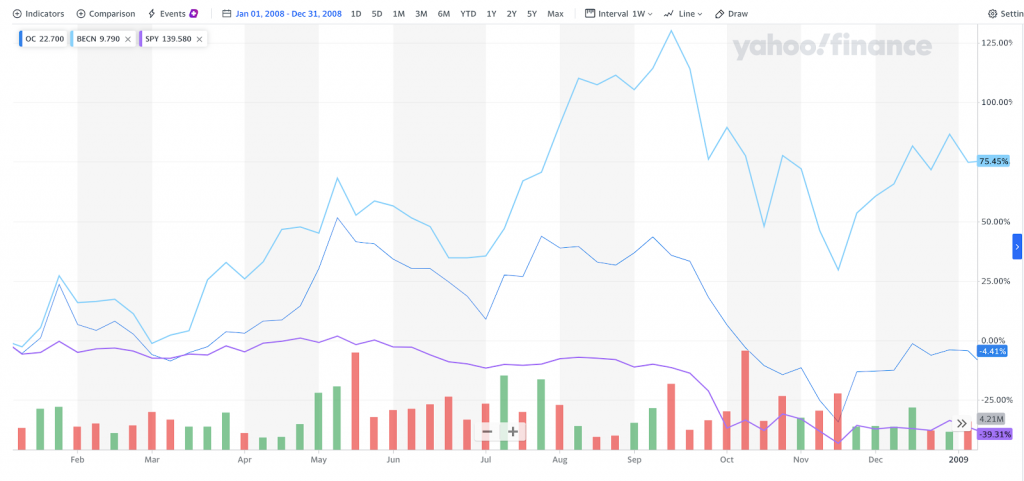
As Trevor Soare points out on SeekingAlpha, both companies took a big hit around the recession of 2008. However, the following year the two stocks outperformed the SPY by an average of almost 200%, Soare explains.
(The SPY ETF is the SPDR S&P 500 Trust ETF. This popular fund aims to track the Standard & Poor's 500 Index, which is comprised of 500 large- and mid-cap stocks. The fund is considered a way to track the health of the overall economy.)
The reason for this is simple, according to Soare: “The idea is that a leaky roof will always take priority over the latest smartphone or a new car.”
Marketing Opportunities
One of the biggest growth opportunities for any roofing business can be provided through marketing. In fact, roofing companies generally have a comparatively high return on ad spend (ROAS).
A ROAS of 10 should be the goal for any roofing business. That means for every dollar you spend, you make 10. A ROAS of 5 should be the minimum. You can increase ad spend after inclement weather to try and capitalize on new opportunities.
Commercial Roofing Vs Residential Roofing
If you’re completely unfamiliar with how the industry operates, it’s important to know a few key factors before you start a roofing business.
Before any AEs start busting out the shingles and scaling three-story ladders themselves, there’s one important distinction to make: there is a big difference between residential roofing and commercial roofing.
Fortunately, both types of companies have a lot of potential, and many companies do both residential and commercial work. Still, it’s good to understand the difference, both in terms of revenue and the amount of work involved.
Residential roofing involves the maintenance and repair of roofs for houses. Commercial roofing is concerned with office buildings, apartment complexes, schools, factories, and anything larger than a family home.
Residential roofing involves the maintenance and repair of roofs for houses. Commercial roofing services are concerned with office buildings, apartment complexes, schools, factories, and anything larger than a family home.
Commercial maintenance programs also make sense. For example, cleaning grease from the roofs of restaurants to prevent grease hazards and grease damage.
Let’s look at some of the biggest differences between commercial and residential roofing.
1. Design
This is the most obvious difference between commercial and residential roofs. With commercial roofs, the slope is almost always very low or completely flat. Think warehouses, factories, and apartment buildings.
Commercial roofs are also almost universally larger than residential roofs, and they tend to house heavy items like industrial-sized HVAC units and piping.
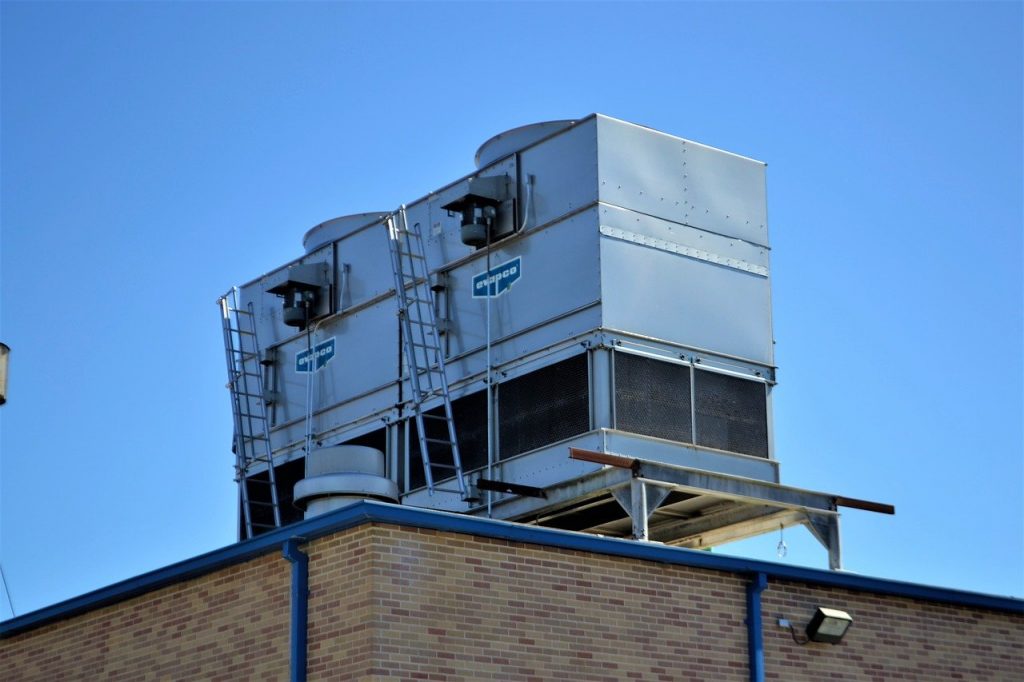
Residential roofs are more slanted, and they usually won’t have anything sitting on them (except possibly solar panels, small exhaust vents, or skylights.)
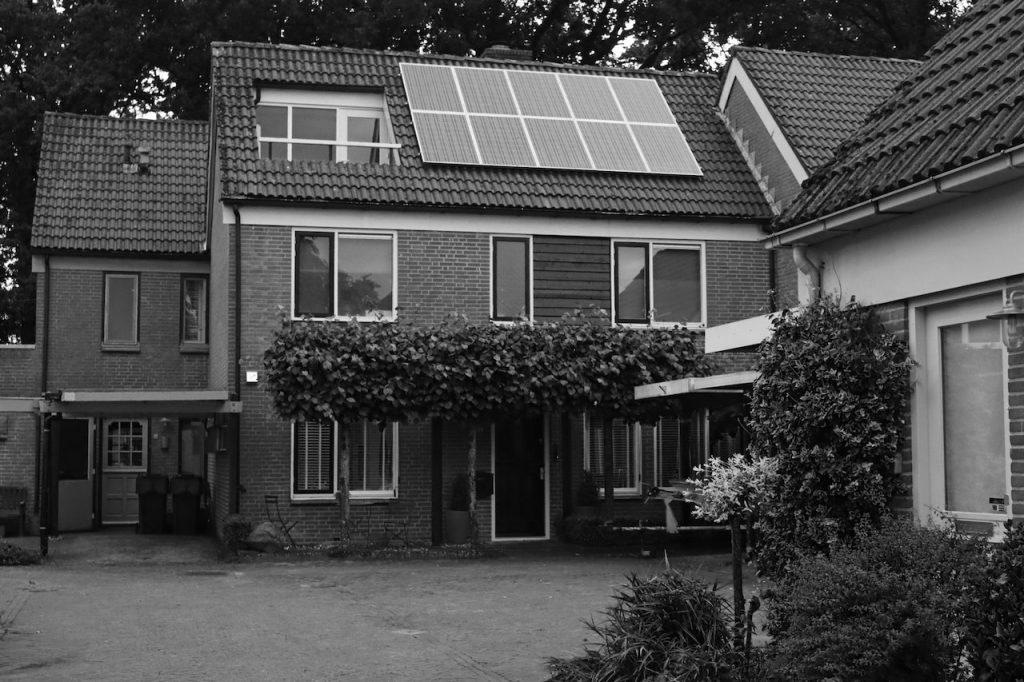
2. Materials
Depending on the design of the roof, the overall cost, and the prevailing weather conditions of the area, the material you use will be different. As a result of the materials necessary in both residential and commercial roofing projects, Working Capital requirements are often higher for roofing companies than other home services businesses.
Asphalt shingles are king in residential roofing. They’re easy to install and cost-effective. Other popular materials include metal panels, slate, wood shakes, tile, and ceramic.
Plywood is usually nailed into the wooden rafters of the home to create the roof deck before the roofer lays down a waterproof protective underlayer. They then install the shingles or tiles.
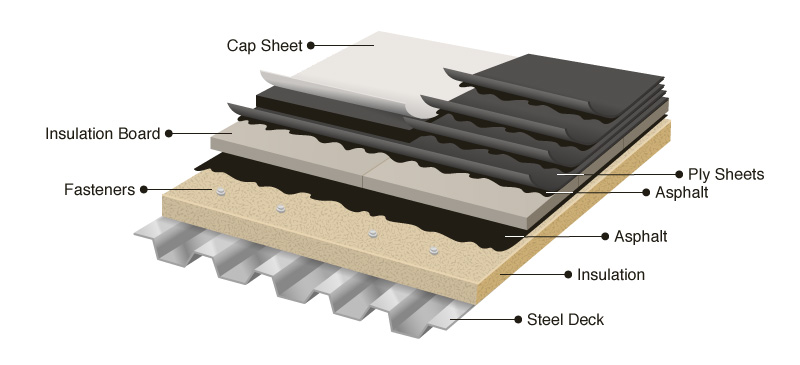
Because commercial roofs are usually flat, they require different materials. Usually, roofers use modified tar, gravel, modified bitumen, polyurethane foam that is sprayed onto the roof, or single-ply coverings.
Commercial roofs are built in multiple layers, including the insulation, decking, protective coat, and reflective coat.
| A Note About Days Inventory Outstanding Days Inventory Outstanding (DIO) is a financial metric that measures the average number of days it takes for a company to turn its inventory into sales. In other words, DIO measures the efficiency of a company's inventory management by calculating the number of days it takes for the company to sell the inventory it has on hand. This is an essential metric for roofing companies in order to help them to manage their inventory effectively. Since roofing material is so cost-heavy, tracking DIO can help companies minimize the amount of money they have tied up in inventory. If a roofing business has a high DIO, it means they are holding onto their inventory for too long, which increases storage costs, obsolescence, and potential write-offs. If a roofing company has a low DIO, it shows they're selling their inventory quickly and that's a positive sign for their business. A low DIO can also indicate that a roofing company has an effective inventory management system in place, which can help them to reduce their costs and increase their profitability. |
Group buying organizations can help roofing companies cut down on the high costs of materials. These organizations work by negotiating bulk purchases of materials directly from manufacturers and distributors. By leveraging the collective buying power of their members, they often secure lower prices and better terms than individual businesses could negotiate on their own.
Joining a group buying organization can also help streamline your purchasing process. Rather than having to shop around for the best deals on materials and negotiate with multiple suppliers, you can rely on the group buying organization to handle these tasks for you. This can save you time and effort, allowing you to focus on other aspects of your business.
3. Installation and Repair
Commercial and residential properties each offer their own unique challenges when it comes to installation and repair.
Commercial roofs can take a month or more to install, thanks to their sheer size and the number of layers involved. Residential roofs can usually be completed in just a few days.
Commercial roof replacement are generally major undertakings. If water manages to make its way through the layers of a commercial roof, the entire thing needs to be assessed. With residential roofs, leaks are usually isolated to spots where shingles are becoming loose. The repair can usually be completed within a few hours, whereas commercial roof repairs can take anywhere from a couple of days to a couple of weeks or more.
The skill level of the roofer is important to consider as well. Commercial roofers need to have an understanding of a number of different building materials as well as how to properly install, repair, and patch each of them. The skillset of residential roofers is less specialized.
Commercial Vs Residential: Post-Pandemic Revenues
Looking into the numbers, the median revenue for residential roofers in 2019 was $500,000 to $999,000, according to Roofing Contractor's State of the Industry Report. Those numbers are, of course, pre-pandemic, but many professionals agree with Soare and believe the industry will bounce back quickly.
75 percent of residential roofers said they expect sales to increase even further in 2021 over 2020.
Nearly half (49%) of residential roofers said they expected their 2020 annual sales to increase compared to 2019. Furthermore, 75 percent of residential roofers said they expect sales to increase even further in 2021 over 2020.
“This could be attributed to the fact that, due to the pandemic, people were unable to go on vacations and had to work from home. In doing so, they had more time to notice problems with their roofs and sought the help of a roofing contractor,” wrote the study’s authors.
Turning to their commercial counterparts, in the midst of the 2020 lockdown, nearly half (45%) of commercial roofers said their sales were up from the previous year. Meanwhile, a majority of those same respondents (68%) said they expect sales to increase again this year.
According to a separate study done by Kingdom Roofing, 78 percent of roof business professionals believe commercial roofing sales will continue to grow into 2021.
While most commercial roofers won’t unveil their annual revenue, the overall commercial roofing materials market is estimated to reach $266 billion by 2024, according to Kenneth Research. If commercial roofers are planning on buying that much material, we can assume they plan on being very busy in the coming years.
Economic User and Gross Profit Margins in the Roofing Industry
When it comes to the roofing industry, gross profit margins can vary greatly depending on the type of customer being served. Here are some of the common customer types and their associated gross profit margins:
Insurance Companies
Roofing companies that work with insurance companies, particularly in “storm chaser” areas, can expect to use claims software such as Xactimate. Learning Xactimate well and figuring out how the processes work will often bring gross margins from 25% up to 45% for residential roofs. This is also a process that you can offshore the majority of the work to do.
However, insurance companies typically set up many hurdles in their claims process, which only a small percentage of companies can navigate successfully. A residential roofing business that knows how to navigate these hurdles can expect 40% or higher gross margins with insurance claims work.
Commercial roofing contractors that can navigate these hurdles can expect closer to 50% gross margins with insurance claims work. Those that do not know how to navigate these hurdles might be seeing gross profit margins as low as 25% for the same work.
However, it’s important to note that there may be some costs associated with entertaining or catering to this group that should not be seen as add-backs when purchasing a roofing business.
Homeowners
In non-storm chaser areas, homeowners are a common customer type for roofing companies. Gross margins for serving homeowners typically range from 40-50%, depending on competition and financing options.
Gutters and little repairs can be very high-margin opportunities. This is especially true of residential roofing but can apply to commercial roofing as well. Either way, your margins will be even better if you make the gutters yourself. By using a gutter machine to shape metal coils into gutters on-site, companies can eliminate the cost of purchasing pre-made gutters from suppliers. Additionally, creating gutters on-site ensures a perfect fit, reducing the risk of installation errors and the need for costly callbacks
Property/Facilities Managers
Many businesses in the roofing industry will find their niche and cater to it. For example, a company may focus on doing all the roofs for a certain chain of restaurants or a certain university. When working with property/facilities managers, it’s common to see gross margins of around 55%. However, it’s important to note that there may be some costs associated with entertaining or catering to this group that should not be seen as an add-back when purchasing a roofing business.
General Contractors
For residential construction, general contractors typically have gross profit margins of around 20%. Therefore, it’s generally better for roofing companies to avoid working with them. For commercial construction, however, general contractors may offer closer to 40% gross profit margins.
Storm-Chasing Companies
In recent years, a new type of company has emerged in the roofing industry: storm-chasing companies. These companies typically operate by following severe weather patterns and offering to repair roofs damaged by hail, wind, or other natural disasters. They may set up temporary offices in affected areas and use aggressive marketing tactics to attract customers.
While storm-chasing companies can be effective at quickly repairing damaged roofs, they have also been the subject of controversy. Many of these companies are not licensed or insured in the areas where they operate, which can leave customers at risk of shoddy workmanship or even fraud. In addition, storm-chasing companies may offer quick fixes that don't address the underlying issues with the roof, which can lead to further damage down the line.
Licensing Requirements By Region
Most states within the union require roofing contractors to register with the local government, but that isn’t universal. If registration is required, it usually comes with fees that often need to be renewed each year.
It’s important to note that the registration isn’t necessarily called a Roofing License and is usually more generally referred to as a contractor’s license.
Many states also require that contractors have insurance before they can complete the registration process. Some states allow homeowners to look up the credentials of contractors.
Because laws change regularly, we’ve compiled a list of states for you. The links connect you to each state’s contractor registration website. However, not every state listed below requires you to register.
The Weather Effect
It’s also important to consider the local weather when buying a roofing company. Residential roofing in Lubbock, Texas, where they have tons of hail, is significantly different from that in Scranton, Pennsylvania, where water damage is more likely.
Many people may not realize that Texas has the most hail and wind claims of any state. The April 2016 hailstorm there was the most expensive ever, costing approximately $1.4 billion.
If you’re already looking for roof restoration businesses for sale, it’s important to consider the main weather elements that can impact a structure’s roof.

- Sun
All roofs will be exposed to the sun’s ultraviolet rays. It’s inevitable. Shingles that are constantly exposed to the sun will become cracked and brittle.
Extreme heat and drastic temperature changes can also cause roofing materials to shrink or expand over time, leading to damage.

- Rain
If an area has heavy and consistent rainfall, small leaks will be more common. If these leaks go unnoticed, they can often lead to significant damage. If the rainfall is continuous, it can create puddles on rooftops, which can weaken certain areas of the roof and cause moisture damage.

- Snow/Hail
During the winter, ice can build up along the roof's edges, damaging the roof and the gutters. If the gutter system is damaged, that can also threaten the building’s foundation.
Heavy hail can cause structural damage to shingles and roofs. If not addressed quickly, this damage can allow moisture into the wood.
Ice dams are also a threat. These ridges of ice can build up over time. When they begin to melt, they cause moisture to seep under the shingles and freeze again when the temperature falls. - Wind
In addition to rain, hail, and snow, wind can significantly impact the roofing industry. Strong winds can cause shingles to lift or even blow off entirely, leaving the roof vulnerable to leaks and water damage. Wind can also cause trees and other debris to fall onto the roof, causing further damage.
Roofing companies should be aware of the potential for wind damage and take steps to mitigate it. This may include installing wind-resistant shingles or using roofing materials that are better suited to withstand high winds. It is also important for roofing companies to educate homeowners on the importance of regularly inspecting their roofs for wind damage and making repairs as necessary.
In areas that are prone to high winds, such as coastal regions or tornado-prone areas, roofing companies should be especially vigilant. They may need to take extra precautions, such as installing additional fasteners or using more robust roofing materials.
Being prepared for wind damage is an important part of any roofing company's business. By taking steps to mitigate the effects of wind, roofing companies can help ensure that their customers' roofs remain intact and their homes are protected from the elements.
| A Note On Due Diligence Obviously, you want to conduct your due diligence on any business you're thinking about buying. This includes looking at financial records, customer information, and company culture. Importantly, when it comes to roofing companies, the due diligence process needs to monitor the weather conditions in the trailing period and ensure they are not out of the ordinary. Extreme weather conditions such as heavy rain, wind, and snow can cause significant delays, damage to materials, and safety concerns for workers, all of which can impact the company's bottom line. But more importantly for business buyers, atypical weather can impact the company's valuation. If there were unusually extreme weather patterns that resulted in additional work, the seller might point to those higher earnings as a reason to charge more for the business. Buyers can avoid this by monitoring historical weather patterns. |
Build Relationships to Create Annual Recurring Revenue
Now that we have a basic understanding of the roofing business as it exists today, let’s explore some ways to improve on the existing business models.
One of the interesting things about roofing–and many home services companies in general–is that there is a lot of room to introduce recurring revenue models to the business.
HVAC is one industry where an annual recurring revenue component has become relatively standard. But that component didn’t exist a decade ago.
The idea is that you want to give your customers peace of mind. To do that, you can offer a package where you inspect their roof once or twice a year in exchange for an annual fee. In the HVAC industry, many companies now provide inspections before the winter and before the summer. They change filters, make sure the vents are clean, and fix anything that has fallen into disrepair.
This is good for the business for a number of reasons. For one, it keeps the company’s technicians busy during downtimes. It also gives the business an opportunity to sell more things, whether it’s a deep cleaning, a new thermostat, or other new products or services.
If you’re able to find the correct price, it can be like a membership club. Your customers pay a certain amount each month, and they receive peace of mind. It’s like an insurance policy that can include labor and parts.
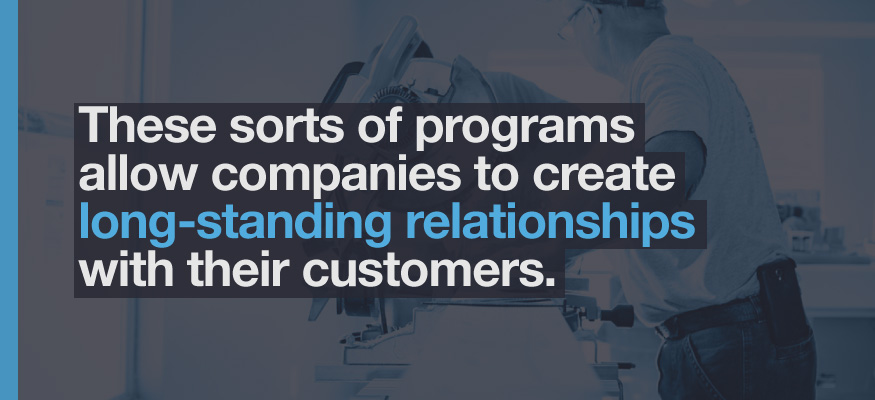
These sorts of programs allow companies to create long-standing relationships with their customers. If you’ve seen the same person every year for the last five years, when something goes wrong, you’ll be the first person they’ll call.
Another component of the industry is that houses and commercial properties switch hands after a certain number of years. If a person buys a house in Scranton, and the roof was inspected seven years ago, they won’t know who did the work or if it was done well.
But if the home seller has a maintenance agreement with a company, they’ll likely pass it on to the new homeowner. And then, the company has a much better chance of getting that new contract as well.
Preparing For The Future
This doesn’t exist in the roofing industry today. But it barely existed in the HVAC sector 10 years ago. If you’re able to take lessons from other sectors and apply them to your business, you’ll be able to create new revenue streams and experience new levels of success.
Acquira has already done a few deals within the space, and we’re looking to do more. If you’ve come across a roofing company that looks like a good deal, schedule a call with us and let us know.
Whether you’re thinking about starting a roofing company or you’re just getting started on your entrepreneur journey, it all begins with our Accelerator Program. It will provide you with all of the training and resources you need to get started. If you'd like to learn more, schedule a call with us, and one of our Acquisition Experts will walk you through the process.
We know that many people have had problems with their roofs in the past, and those often make for great stories. We’d love to hear about your experiences in the comments below. And if you found this article useful, please share it around.
Key Takeaways
- Roofing businesses are recession resilient.
- Historically, the industry bounces back after economic downturns.
- Commercial roofing and residential roofing are both good potential acquisition options.
- Local weather and state licensing requirements will impact your business.
- You should consider implementing a recurring revenue model for the business.
Acquira specializes in seamless business succession and acquisition. We guide entrepreneurs in acquiring businesses and investing in their growth and success. Our focus is on creating a lasting, positive impact for owners, employees, and the community through each transition.



